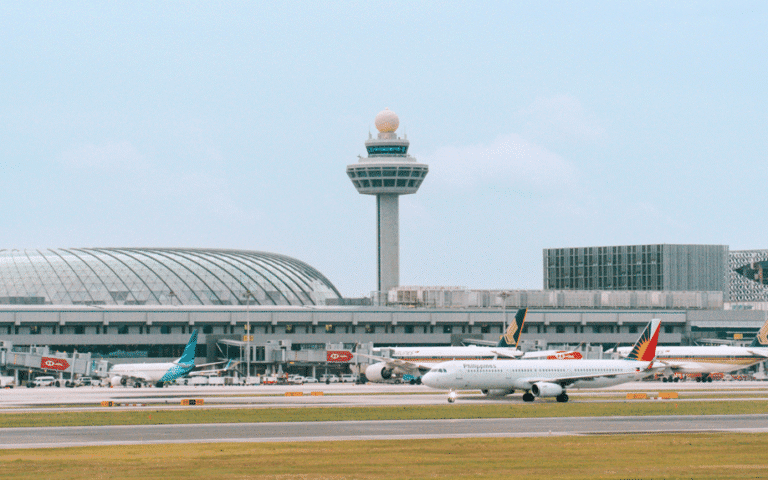- Changi Airport is increasing cargo capacity from 3 million to 5.4 million tonnes by the mid-2030s through Terminal 5, the Changi East Industrial Zone (CEIZ), and ALPS 2, integrating automation, robotics, and autonomous mobility to meet rising Asia-Pacific cargo and passenger demand
- The airport leverages its proximity to PSA Singapore’s port to enable seamless air-sea transshipments, supporting flexible, diversified logistics networks as a hedge against geopolitical or supply chain disruptions
- Upgrades such as SATS’ Bulk Unitisation Programme Handling Centre and S$250 million SG Hub enhancements improve turnaround times, terminal capacity, and cargo handling efficiency, ensuring Changi can manage current volumes while preparing for future growth
Singapore’s Changi Airport is advancing one of the most ambitious cargo infrastructure expansions in Asia, even as the global airfreight sector enters a more subdued growth phase.
Following a sharp 15 percent increase in international air cargo throughput in 2024, growth at Changi slowed to 4 percent year-on-year in the first seven months of 2025. Despite this moderation, the airport is continuing with plans to increase its cargo handling capacity from 3 million tonnes per annum to 5.4 million tonnes by the mid-2030s.
That growth will be enabled by the development of Terminal 5 (T5), the Changi East Industrial Zone (CEIZ), and a major expansion of the Airport Logistics Park of Singapore (ALPS 2). In a region where many hubs are reassessing timelines or taking incremental steps, Changi’s all-in strategy stands apart.
Building for long-term demand
“Asia Pacific is among the fastest growing markets over the next two decades,” said Lim Ching Kiat, Executive Vice President, Air Hub and Cargo Development at Changi Airport Group. “Changi Airport is well-poised to serve this rise in passenger and cargo demand with additional capacity.”
The International Monetary Fund forecasts continued GDP growth of around 4 percent for Southeast Asia through 2030. Changi is positioning itself to serve not just growing volumes but also evolving flow patterns and cargo needs. T5 will be fully integrated into the wider Changi ecosystem and feature automation, robotics, and trials of autonomous mobility for baggage, passenger, and cargo transfers.
CEIZ, meanwhile, will focus on airfreight, air express, and maintenance, repair, and operation (MRO) activities, backed by a remodelled Changi Airfreight Centre and the twin ALPS zones for integrated logistics. “With land intensification, operational excellence, sustainability, and process innovation as the core planning parameters, CEIZ will better serve airfreight, air express and MRO activities at Changi Airport,” Lim noted.
Intermodal plays to resilience
Changi’s expansion goes beyond volume. It includes a growing push into multimodal connectivity — a potential hedge against volatility in air cargo alone.
“Singapore plays a key role as one of the major transshipment hubs in the region, including facilitating multimodal connectivity,” Lim said. “Changi Airport has been working closely with PSA Singapore to drive intermodal transportation cargo flows through Singapore.”
The proximity between Singapore’s port and airport — both among the busiest globally — is being leveraged to enable seamless air-sea transshipments. This approach reflects a broader shift toward flexible, diversified logistics networks as a safeguard against geopolitical or supply chain shocks.
Operational upgrades during the wait
While T5 and CEIZ are long-term bets, Changi is also investing in near-term operational efficiency. Earlier this year, SATS opened its new Bulk Unitisation Programme (BUP) Handling Centre, designed to improve turnaround times and reduce terminal congestion.
“The BUP Handling Centre is built to improve turnaround time of Bulk Unitisation Programme (BUPs), reducing the minimum processing time by 20 percent,” Lim explained. The facility also supports Just-In-Time lodgement and frees up capacity at existing terminals.
SATS has also committed around S$250 million to upgrade its SG Hub over the next five years, including more than S$150 million for renewal and expansion of its Ground Support Equipment fleet, and S$100 million to enhance cargo operations.
These incremental improvements suggest Changi is not simply building for a distant future — but also adapting its current operations to handle near-term complexity more efficiently.
Changi’s strategy assumes that long-haul consolidation hubs will retain their value, even as direct services to secondary cities increase. The plan is to serve both high-density flows and complex transshipment and value-added logistics needs.




